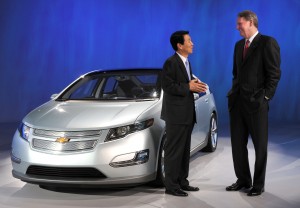
LG Chem President and CEO Kim Bahn-suk (left) meets with former GM Chairman Rick Wagoner in front of the Chevrolet Volt electric vehicle. Could future EV batteries come from Michigan?
It’s been a Winter of discontent, as Shakespeare might say, in Michigan, as the state’s automotive economy steadily vaporizes. With sales plunging and two of Detroit’s Big Three threatened with extinction, the only real business opportunity, these days, is providing U-Hauls for people moving out of state.
But can Michigan find an opportunity to reinvent itself as the center of a more environmentally friendly automotive industry? That’s the goal of the state’s economic development officials, who will be handing out $400 million in tax credits, later today, to four firms that could help make Michigan ground zero in the production of the advanced batteries needed to power tomorrow’s green machines.
While there are still plenty of skeptics, there’s a growing push to replace – or at least supplement – the internal combustion engine with electric power. There are already more than a dozen hybrid-electric vehicles on the market, ranging from the Toyota Prius to Ford’s new Fusion Hybrid. And about 18 months from now, General Motors hopes to take the technology to a new level with the introduction of its Chevrolet Volt, a so-called Plug-in Hybrid, which will use battery power for daily commuting and a small gasoline engine for longer trips. Then there are the pure battery-electric vehicles, or BEVs, such as Tesla’s Roadster and planned Model S family sedan, which will eliminate the internal combustion engine entirely.
“Mass energy storage is a critical need (that has) gone beyond the tipping point,” contends Eric Schreffler, sector development manager for the Michigan Economic Development Corp., the quasi-public agency which will choose the recipients for the new tax credits.
The problem is that the fundamental technology needed by all these vehicles doesn’t exist in the U.S. True, there are plenty of research centers, across the country, working on the physics of lithium-ion and other advanced batteries. But with the exception of one small factory, in Indianapolis, the world’s supply of tomorrow’s power cells come entirely from abroad, and almost exclusively from three Asian nations: Japan, China and South Korea.
There are those who don’t see a problem with this, usually the same folks who believe that America can survive without a significant manufacturing base. But others are starting to question that concept, including the Pentagon, which sees advanced batteries as a strategic resource, as critical as the aircraft, vehicles and smart bombs that will use that technology.
“I… know where I want the fuel-efficient cars of tomorrow to be built,” then-candidate Barack Obama declared, during a visit to Lansing, Michigan, last August, “not in Japan, not in China, but right here in the United States of America. Right here in the State of Michigan.”
Five months later, during a news conference at the North American International Auto Show, in Detroit, General Motors seemed to be backing up that goal when it showed off the production version of its Chevy Volt, and followed that with news that it would build a new battery plant to provide the lithium-ion packs for the plug-in. But much of the initial media coverage missed the fact that the proposed GM facility would simply assemble into packs the LIon batteries produced by LG Chem at its factory in South Korea. Gm still hasn’t announced whereor when a U.S. plant will be opened.
Could battery production be shifted to the U.S.? It won’t be easy – nor will it be cheap. At the least, a new factory will cost at least $300 million, and true state-of-the-art facilities – which in many ways resemble the rigorous production environment used to make silicon chips – run up to $1 billion, according to industry sources.
To help spur a U.S. battery base, now-President Obama announced a $2.4 billion program, last month, most of the money promised for battery production. Michigan, meanwhile, despite its serious cash problems, has found the resources for the so-called MEGA credits. And when added to other programs enacted by state lawmakers, the figures could eventually run well above the half-billion mark.
Will Michigan win the race? There are plenty of obstacles in its way, everything from concerns about unions to the state’s notoriously bad winters. But there’s an intellectual base here, with some strong research programs, especially at the University of Michigan, in Ann Arbor. If it survives its current problems, GM has promised to fund a huge expansion of that UofM program.
While there’s no guarantee the battery will ultimately replace the internal combustion engine, it’s likely there’ll still be a significant role for LIon and other technologies in the years to come. The battle to control production is likely to be fierce, and Michigan appears anxious to win this fight, for without a battery production base, its role in the automotive industry of the future will continue to shrink.
Editor’s note: This story was revised to reflect the expanded number of companies offered tax credits.
